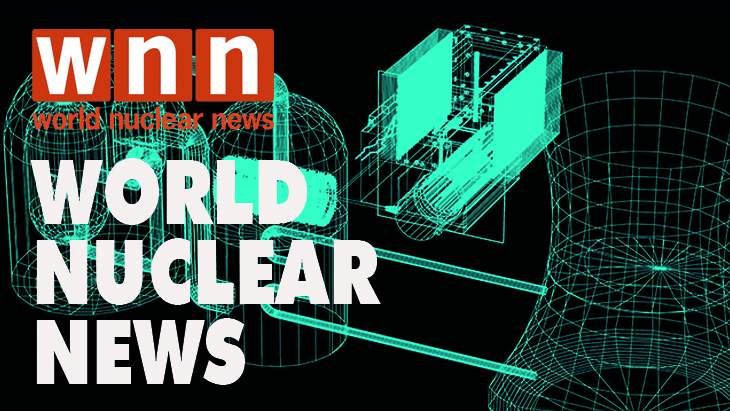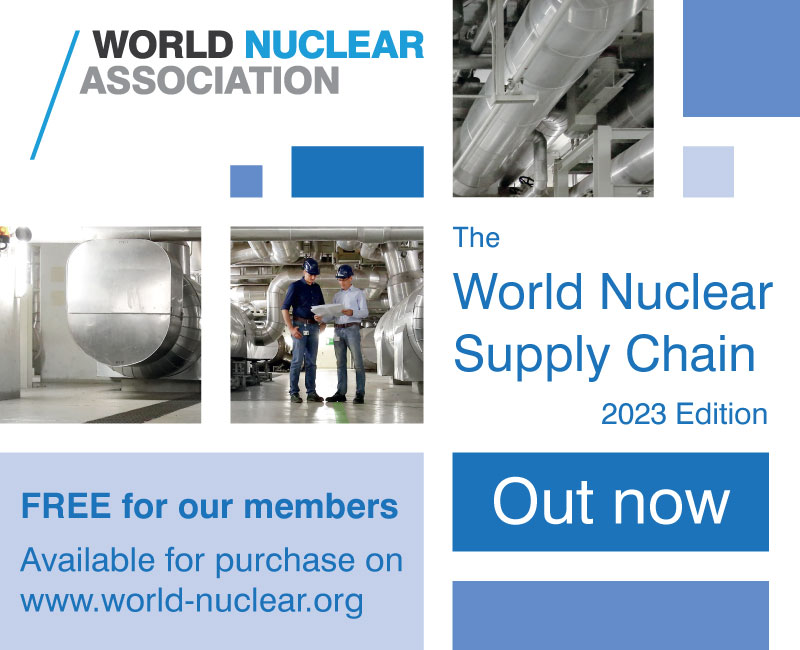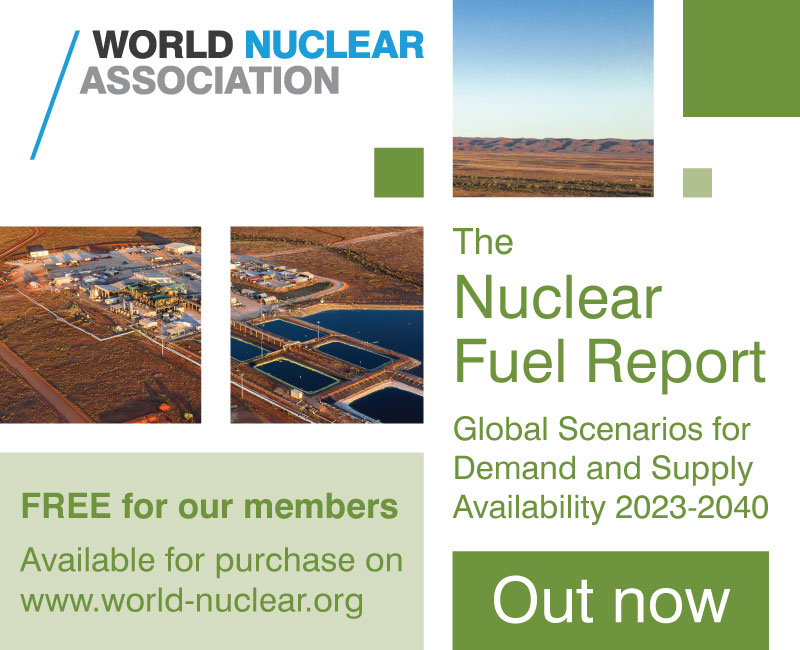What are the fuel cycle challenges of tripling nuclear capacity?
Leading figures from across the fuel cycle say they are ready to meet increased demand, but set out areas where change is required to help make it happen, in a World Nuclear Symposium session.
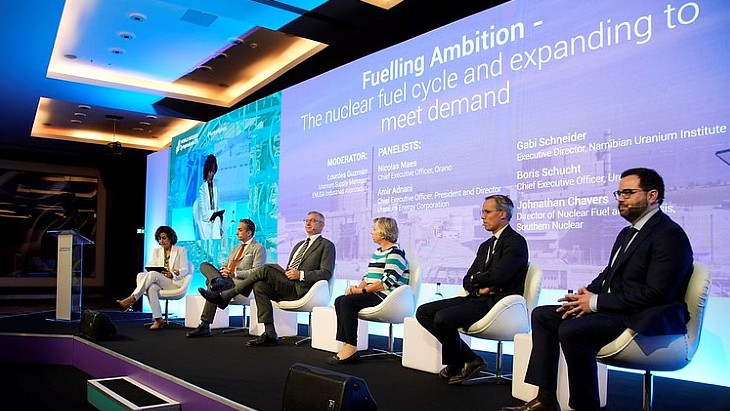
The background
More than 120 nuclear energy and technology companies and 25 countries have signed up to the pledge to aim to at least triple global nuclear energy capacity by 2050. One key question is how fuel supplies will be able to expand if such a goal is to be achieved. Here are extracts of what key sector figures said during a discussion on the subject.
Nicolas Maes, CEO Orano
Nicolas Maes said that on mining Orano's current strategy was to expand existing projects, while in the medium term it was "revisiting our exploration policy and the means that we are allocating to exploration ... we believe that there are many areas in this world that have been vastly unexplored". It was also developing "mining techniques to make deposits that were today not so accessible, accessible - or non-conventional deposits that could make sense now". He used the analogy of the idea of "peak oil" saying that it was talked about in the 1920s "people were already fearing they would miss oil, and then techniques developed and they found new deposits and all the rest, and peak oil still hasn't materialised. We believe that in investing in exploration and exploration techniques as well as in mining techniques" that will increase the uranium sources available and will cater for the "medium term", which he categorised as the next 40 to 50 years. For the longer term, he said that recycling was a big focus.
In terms of conversion and enrichment he said that production had been expanded over the past few years - Orano plans to extend enrichment capacity at its Georges Besse II uranium enrichment plant in France, with Maes saying the aim is for first concrete for the extension in October this year, targeting the start of production in 2028. He said expanded capacity required a "massive investment compared to our scale and that can only be done if we've got visibility and the utilities support us in doing that". For LEU and HALEU, he said that the technologies are there but it was "chicken and egg stuff from the market", and transport issues need to addressed. For MOX-fuel based fast breeder and molten salt reactors he said the designers should be "thinking from the very early days about the fuel supply chain because that fuel supply chain doesn't exist yet" and also that "standardisation is key".
He added that, more generally, "we need strong decision-making and timely decision-making from politicians. We need creative financing schemes, and we need the industry to deliver on time and on budget".
Jonathan Chavers, Director of Nuclear Fuel and Analysis, Southern Nuclear
Jonathan Chavers said there was a chicken and egg situation between the suppliers and end users - "utilities desire firm pricing, predictable scheduling. The suppliers want firm contracts before they'll make the capital investments to get you the material you want on the schedule you want" and the question is how to get people "to take the big bet". He highlighted as a success the accident-tolerant fuel programme "where you have policymakers, utilities and suppliers all aligned and working together".
Chavers also focused on the transportation involved in the nuclear fuel supply chain. "Historically, utilities have not paid that much attention to the logistics. We depended on the suppliers just to ensure that things were moving as it needed to and got to the deliveries that we needed," but in reality, uranium mined out of an asset in North America "may cross the Atlantic multiple times before it's in a final fabricated fuel assembly that's put into our nuclear reactors". This means inventories have been built higher to ensure cover for any supply chain disruption "so frankly today we're getting by and we're creating some insurance policies, for lack of a better word" for any logistics disruptions. "If we really have this demand growth and build-out of nuclear capacity do we have the logistics infrastructure in place to support that additional volume that's going to be needed to go back and forth, especially between Europe and the US to ultimately get us to a final fabricated assembly?"
On the question of a single thing to help in terms of the tripling nuclear capacity goal, he said that all those involved in the symposium discussion in London were from different companies and parts of the industry, but were all nuclear professionals, and "we're always just one bad news story away from losing the momentum that we have" so the priority was "safety first and superior performance - as long as we execute on those, all the rest of it will work out".
Boris Schucht, CEO Urenco
Boris Schucht said that the momentum "which is now expressed in the tripling of nuclear is fantastic - that is something we have not seen". There were questions about whether the goal was realistic but, looking at the example of China today and France between 1970 and 2000, it was possible to triple capacity. But the current momentum needed to be maintained, he said and "it should not be a straw fire". It was also necessary for political ambitions to be translated into political action - on people and education, nuclear regulations, financial regulation, supporting the supply chain, the generators "and I think a lot of countries are working on that". The other issue was the industry had to deliver projects on time and on budget.
As with other speakers, Schucht referenced the chicken and egg situation, saying that when it comes to HALEU supplies, Urenco was ready to sign contracts wth advanced and small modular reactor projects. "I want to use the opportunity to motivate our potential new customers in the room and to go ahead ... it's about the whole ecosystem. You need transport packages, you need a lot of things, a lot of regulatory question ... a lot still that we have to develop ... that needs to be based on real contracts on real projects so that we really understand what is needed. So I'm optimistic on it, but we are not yet fully there. We have done the first, I think important step, but that needs to continue."
On the question about key measures to pave the way to capacity expansion, Schucht said that politicians need to continue "to translate the political momentum into political actions, and that's not only about legislation, finding solutions, but also giving long-term guidance to the market, to the industry. We all make decisions that will operate for the next 40, 50, 60 or 70 years" which is hard if "you always have the fear that the next government is taking opposite political decisions".
Gabi Schneider, executive director of the Namibian Uranium Institute
Gabi Schneider said that "during the period of low uranium prices - or the sleeping period as I heard somebody referring to it during the course of this week - we did not sleep, but companies active in Namibia rather used the opportunity, the time that was available to work on their programmes ... there was many a drilling campaign to increase the resource space ... so as a result, now with the situation where the price has reached a level where many projects can come to fruition, all of this work was already done". She said that her "optimistic outlook" was that if all projects come to fruition, "Namibia will be able to, not triple its output, but to more than double the output".
In response to the question of what the most important thing that needs to happen to facilitate a tripling of nuclear capacity by 2050, she said that from an African perspective "I think to reach this goal, we need a lot of uranium. So we need to find a lot more uranium deposits. I think we need a lot more exploration, so it is up to individual countries to put a conducive environment in place ... legal, infrastructure and all the other issues that are required to build world class uranium mines".
Amir Adnani, CEO Uranium Energy Corporation
Amir Adnani said that although it was starting from a low base the USA was currently the "fastest growing jurisdiction for uranium exploration and mining in the world" with potential production growth "to 20 to 25 million pounds per year within five years". He added: "We're seeing this unprecedented need for new suppliers to emerge in our industry. If we're going to truly have the foundations for a global, robust industry it starts with uranium ... historically, in the 1980s the US-led the world in uranium production ... so this is not a lost art and science. The regulatory framework exists ... we have very understanding capital markets in North America that understand this business ... and this unbelievable bipartisan support".
He likened his company's strategy during the bear market to someone buying Christmas decorations for the following year in the January sales. He also added that, irrespective of geopolitics, "there has to be a robust domestic answer as well to the fuel cycle - we can't be importing everything" and praised govenment initiatives in the USA whoch have "levelled the playing field with renewables", in terms of the subsidies they had benefited from.
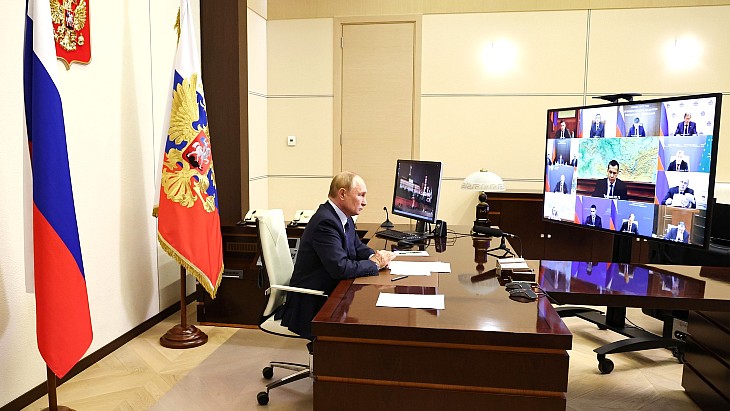

.jpg)
_1.jpg)






